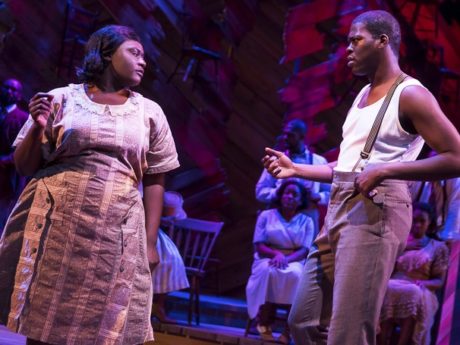This revival of The Color Purple opened at the Bernard Jacobs Theatre on Broadway in December of 2015 but I wasn’t able to get to it until tonight, in the fourth month of its successful run. It had almost unanimous raves and I now add my own delight in writing another.

John Doyle, in charge of direction and musical staging, has stripped other shows like Company and Sweeney Todd to their essentials, bringing greater focus to their central characters. Mr. Doyle’s approach as a director has always singled him out as an innovator, and some of his choices in the past have escaped me, though virtually all of them have added to the impact of this material, even though it is still the written work of Marsha Norman as book writer, and Brenda Russell, Alee Willis, and Stephen Bray as composer/lyricists. One of its many achievements is the cohesion of the written material, even though it’s by a quartet of collaborators. By simplifying the physical production, which is less populated and more simply set and staged than the original, Mr. Doyle has delivered a crowd-pleasing winner.
Based on the Alice Walker novel and the Warner Brothers film of the same title, he’s cast the piece impeccably and he is greatly aided by four exciting actresses to tell the story of Celie, her sister Nettie, Shug Avery, and Sofia, four women living out their difficult lives in Georgia in the first half of the 20th century.
We first meet Celie, played with star quality by the luminescent Cynthia Erivo, when she is fourteen singing a children’s song with her sister before circumstance changes the direction of their lives forever. Nettie is wanted in marriage by a man simply called “Mister” but she refuses him and is sent away as punishment. Celie, the less pretty of the sisters, has already born two children, and they too are taken from her, as she is bound by a man she thinks is father, to Mister. A free woman without options, she has nothing to help her except her abiding faith in God, and her fervent wish that He will protect her from further harm.
This musical, rich in colorful characters, follows Celie through the years, forty of them, giving us a story of a woman’s rise from total lack of self-worth to one of accomplishment, helped along the way by a free soul called Shug Avery, another poor black girl who decided long ago that she was going to be in charge of her own destiny.
There is much gospel in the music, and his leading ladies have the voices to deliver the goods. Time and again Ms. Erivo, the Oscar winning Jennifer Hudson (for the film version of Dreamgirls), and the astonishing Danielle Brooks, who makes an iconic character of the libidinous Sofia, fill the theatre with melody and mirth. Erivo has enormous range, and she understands the value of variety in her well structured performance as Celie.
In her full maturity in the final scenes of the musical, she has grown from a tender abused child to a woman with a sense of purpose, one who has managed, against formidable odds, to make a life for herself as a designer of clothes.

There are a handful of major male characters as well, but clearly this musical’s book is by a feminist writer, who hasn’t much regard for them. Mister is a demon, a Simon Legree. Harpo, his son (married to the formidable Sofia) is a likable oaf, a very tall sexy adolescent who is totally ruled by his powerful wife. There are others, but The Color Purple’s women turn its men into mice again and again. The wish fulfilling conclusion may be unrealistic, but it is exactly what audiences want for Celie and her friends.
The set consists of a high-rise wall on which are fastened dozens of straight backed wooden chairs, and chairs would seem to be Mr. Doyle’s metaphor for something I didn’t quite catch. The loose ones onstage do serve as weapons, instruments, benches, and they eliminate the need for more realistic props. The set design, also by John Doyle, suggests the rural town in Georgia where the action occurs, and it offers ease in allowing the ensemble to effortlessly appear whenever needed.
This is another example of a musical revival which is more arresting than the original production. Casting, design, concept are all refreshingly original, and I highly recommend you go see it.
Running Time: Two hours and 20 minutes, including one intermission.
The Color Purple is playing at the Bernard Jacobs Theatre – 242 West 45th Street, in New York, NY. For tickets, call Telecharge at (212) 239-6200/(800) 432-7250, or purchase them online.
Note:
Last night I couldn’t help recalling sitting decades ago in this same theatre (then called the Royale) and enjoying every moment of Julie Andrews and company acting and singing us another musical story called The Boy Friend. And believe it or not, we heard every delicious Sandy Wilson lyric without the assistance of any mics at all! It’s what we used to call “live theatre.”
The sound last night was ‘pumped up’ and I admit it though, my fellow viewers were on their feet cheering the high notes, so I will respectfully disagree, but bow to the popular view that when it comes to sound, more is better.





